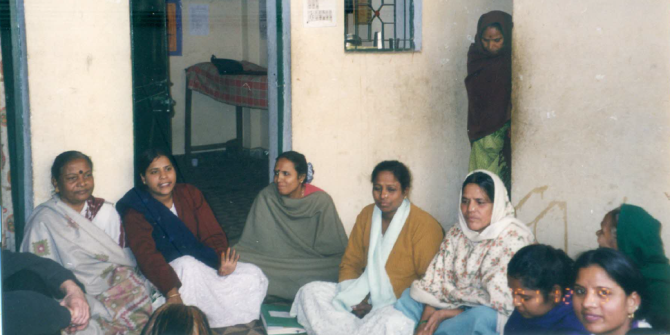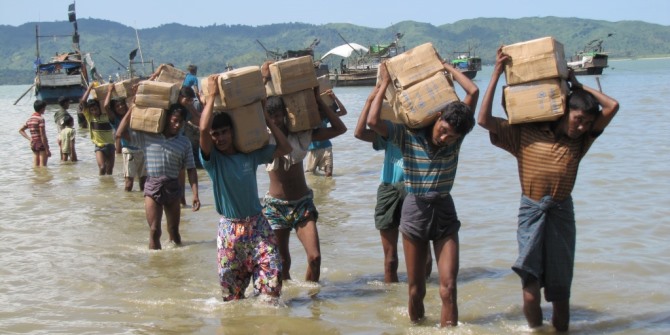In India, linguistic reorganisation solidified support for the Indian state and the Indian nation, rather than leading to political balkanisation and the breakup of the country. Katharine Adeney writes that not only is secession never the easy option, but a rallying cry for secession will only be successful if the group feels its identity and interests are not protected.
Ethnofederalism (where the boundaries of at least some of the federal units coincide with ‘ethnic’ boundaries) has been contested as a solution for diverse societies e.g. Nepal (where the design and number of units remains heavily contested) and Myanmar (where ethnic minority demands for increasing federalisation have had to take a back seat to the demands for increasing democracy).
Concerns are expressed that ethnofederalism will increase pressures for secession and/or lead to increased violence, through increasing a sense of separateness of the people living within that territory, providing resources for political entrepreneurs to mobilize groups against the centre. The recent independence vote in Catalonia is a case in point.
The “dangers” of ethnofederalism
There are 27 federations in the world today: just over half are ethnofederal.
Federations in 2017
| Name of state | Ethnofederal | |
| 1 | Argentina | |
| 2 | Australia | |
| 3 | Austria | |
| 4 | Belgium | Yes |
| 5 | Bosnia-Herzegovina | Yes |
| 6 | Brazil | |
| 7 | Canada | Yes |
| 8 | Comoros | |
| 9 | Ethiopia | Yes |
| 10 | Germany | |
| 11 | India | Yes |
| 12 | Iraq (in transition) | Yes |
| 13 | Malaysia | Yes |
| 14 | Mexico | |
| 15 | Micronesia | |
| 16 | Nepal | Yes |
| 17 | Nigeria | Yes |
| 18 | Pakistan | Yes |
| 19 | Russia | Yes |
| 20 | St Kitts and Nevis | |
| 21 | South Africa | Yes |
| 22 | Spain | Yes |
| 23 | Sudan | |
| 24 | Switzerland | Yes |
| 25 | UAE | |
| 26 | USA | |
| 27 | Venezuela |
Historically, however, 68 percent of federations that have failed have been ethnofederations. These data illustrate that there is a case to answer, and make India’s “success” all the more striking.
- Those opposed to federal homelands express concern that they will increase the desire for secession. They argue that it is in the interests of local elites to increase a sense of separateness, solidifying the boundaries of the group.
- They also argue that ethnofederalism increases the resources with which to effect secession. Thus, a Chief Minister of a state can legitimately claim a democratic mandate to oppose central policies as well as securing control over governing structures and security institutions.
- Finally, concerns are raised that the creation of ethnic homelands will lead to minority victimization and possibly violence, which may not be prevented (indeed, it may even be encouraged) by local control over law enforcement, as was seen in Gujarat in 2002.
These arguments are not without merit. However, they rest on the assumption that the creation of ethnic homelands will lead to secessionist pressures. However, in India, rather than leading to political balkanisation and the breakup of the country, linguistic reorganisation solidified support for the Indian nation. Not only is secession never the easy option, but a rallying cry for secession will only be successful if the group feels its identity and interests are threatened. Ethnofederal institutions can create security and the conditions where it is not in elite interests to pursue secession. Elites need a motivation to pursue secessionism (and of course, the population needs to be motivated to respond to them).
However, secessionist movements have occurred in India and there are areas where India has only managed to maintain its territorial integrity through the use of extreme force. Does this indicate that territorial recognition may be dangerous in some instances? My research indicates that those federal units that retain high levels of diversity fail to increase the security of the group within that unit. Almost half of the states of India retain significant heterogeneity. In these cases the dominant group feels threatened – as has been in the case of Assam, Nagaland and Punjab – which often leads to the targeting of minorities. In contrast, after the creation of the more homogeneous state of Mizoram, it has been much more stable. This is a recommendation for the creation of as homogeneous units as possible.
In addition, territorial autonomy when combined with central power sharing significantly reduces the chances of violent conflict. The Congress Party’s national reach ensured the nationwide inclusion of groups within its ranks, and after its decline of the Congress, coalition politics maintained the regional diversity of Indian cabinets, especially with regard to maintaining the North-South balance. When this power sharing does not exist (or territorial autonomy has been downgraded), conflict is more likely to develop. The cases of Punjab, Jammu and Kashmir and most of the Northeastern states demonstrate why this is the case. Many (although not all) of these so-called “peripheral” states of India have experienced a disproportionate amount of President’s Rule applied to them: out of the top five States, three are in the “peripheral” regions, with Punjab topping the list.
In both Punjab and Kashmir, intervention and political meddling by the central government provoked a violent response. In Kashmir, the subject of electoral manipulation since the 1950s, insurgency did not develop until the late 1980s, after the rigging of the 1987 election. This confirmed for many the impossibility of change within the “system”. The securitisation of the response from the centre through the use of mechanisms such as the Armed Forces Special Powers Act (AFSPA) demonstrates this. Although ten people lost their lives at the hands of police bullets in the Patidar protests in 2015, the situation is incomparable to the use of pellet guns in Kashmir in 2016. Within six months 100 people were estimated to have been killed and 6,000 injured; several of the victims under ten years old.
Support from outside actors obviously has a role in explaining some of the logistical support provided to groups opposed to the Indian state. But the role of the Central government either in failing to accommodate the demands of these groups demonstrates that violent conflict cannot be divorced from the fact that these states have been treated differently from the rest of the Union and their effective autonomy has been reduced rather than increased. Similar arguments about the reduction of autonomy increasing conflict have recently been made in the case of Catalonia.
Policy implications
Territorial recognition promotes security and a belief that the interests of the group are valued and protected by the wider state. Nowhere is this more evident in the fact that regionalist political parties have sought to capture central power within the existing system in India. In the South Asian context therefore, demands for “ethnic” provinces, such as in the Seraiki region of Pakistan and in the Madhesi regions of Nepal, should not be feared, they are likely to increase rather than decrease affinity with the central state. The states of India that have continued to experience violent conflict after territorial reorganisation along ‘ethnic’ lines have been those in which sizeable pockets of diversity remain e.g. Nagaland and Assam.
However, this comes with a caveat: such autonomy should be part of a wider accommodation of groups within central power structures. Access to central power is important. India has had an informal tradition of maintaining a north-south balance in governing institutions: Modi would do wise to remember this. The northern domination of his cabinet and his government’s promotion of Hindi above other languages pose a challenge to India. In states such as neighbouring Myanmar it is important not to pursue a majoritarian-led democratisation. A truly representative democratisation is vital. The lessons from the Indian experience should inform the constitutional reconstruction process in other divided societies such as the Philippines and Myanmar.
Cover image credit: Shivam CC BY-SA 4.0
This article originally appeared on IAPS dialogue and is reposted with permission. It gives the views of the author, and not the position of the South Asia @ LSE blog, nor of the London School of Economics. Please read our comments policy before posting.
About the Author
Katharine Adeney is Professor of Politics at the University of Nottingham and Director of the Institute of Asia and Pacific Studies. The arguments made in this post were developed at length in India Review. She has published widely on both Pakistan and India. She tweets @KatAdeney.







